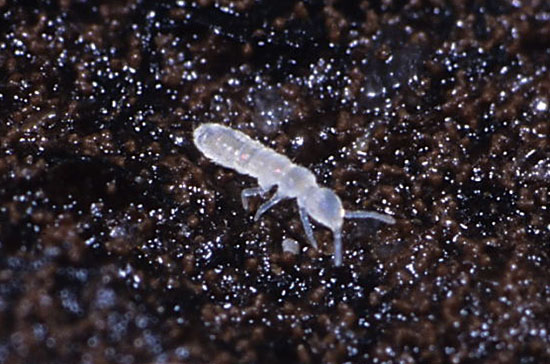Issue 10, June 29, 2015
Springtails
Springtails are tiny, jumping insects associated with turf, mulch, and nearby areas. Most species are one-sixteenth to one-eighth inch long, although there are some giants that approach one-quarter of an inch. They are particularly numerous in moist and wet areas. There are even aquatic species that live on the water surface.
Springtails are elongate, cylindrical insects with simple eyes and obvious antennae. Perhaps their most obvious trait is a slender, forked furcula that extends from the posterior end of the abdomen and is carried folded up under the abdomen. When disturbed, the furcula is released, striking the surface with enough force to send the springtail flying up into the air. Many springtails jump two to three inches into the air, a considerable feat for such a small insect. Springtails also have a collophore which is a broad, tube-like organ extending downward from the front of the abdomen. It is probably used in maintaining a proper internal water balance.

Springtail.
Springtails not only live at the soil surface, but also several feet down. Different species live progressively deeper. Species that live just a few inches below the surface have a reduced furcula that is eventually lost in deeper-dwelling species. After all, being able to jump serves no purpose when surrounded by soil. Species that live deeper in the soil also do not have eyes.
Springtails have very tiny mouths and are unable to bite humans. Some people are apparently sensitive to their scale-like setae or hairs and develop irritated skin when springtails are numerous indoors.
Springtails are perhaps the most numerous insects in the world. Every cubic foot of soil from the poles to the tropics contains large numbers of them, with populations commonly estimated at 3000 per cubic foot. They feed on molds and mildews which require dead organic matter, and both springtails and fungi need high moisture levels. Their feeding on fungi has resulted in their consideration as natural control agents for Pythium and other destructive fungi. Springtails increase in number and become obvious when dead organic matter and moisture is abundant.
Springtails become abundant outdoors when turfgrass is over-fertilized, producing extra thatch, and is over-watered either by humans, rainfall, or both. Similarly, they become abundant in mulch when it is too wet for long periods. The answer to reducing the springtails is reducing the fertilization and watering. Insecticide applications have little lasting effect as they kill exposed individuals but sprays do not penetrate very deeply into soil and decaying plant material where most springtails live. (Phil Nixon)
Author:
Phil Nixon